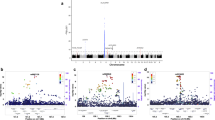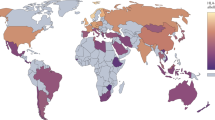Abstract
Multiple sclerosis (MS) is an autoimmune disease displaying different clinical courses. In this multifactorial disease complex environmental as well as genetic predisposition factors contribute to the disease manifestation. Following the candidate gene approach we analysed several genes of the NFκB cascade, which are prime candidates for MS because of their involvement in almost all immunological reactions. MS association was excluded for the NFKB1 and NFKB3 genes, which show remarkably low degrees of polymorphism. The genes of NFκB inhibitors exhibit more sequence variations. In the IKBL gene a predisposing allele was identified (13.1% vs 7.5% in the control group, P < 0.001). This difference in the allelic distribution was even increased in the group of MS patients with a relapsing remitting course of the disease (14.9%, P < 0.0001). A protecting allele was found in the NFKBIA promotor for the patients with primary progressive MS (15.4% vs 28.4% in the control group, P < 0.01). Given predisposing alleles increase MS risk dramatically in certain combinations.
This is a preview of subscription content, access via your institution
Access options
Subscribe to this journal
Receive 6 digital issues and online access to articles
$119.00 per year
only $19.83 per issue
Buy this article
- Purchase on Springer Link
- Instant access to full article PDF
Prices may be subject to local taxes which are calculated during checkout


Similar content being viewed by others
References
Martin R, McFarland HF, McFarlin DE . Immunological aspects of demyelinating diseases Annu Rev Immunol 1992 10: 153–187
Steinman L . Multiple sclerosis: a coordinated immunological attack against myelin in the central nervous system Cell 1996 85: 299–302
Weinshenker BG, Bass B, Rice GPA et al. The natural history of multiple sclerosis: A geographically based study Brain 1989 112: 133–146
Ebers GC, Bulman DE, Sadovnick AD et al. A population-based study of Multiple Sclerosis in twins N Engl J Med 1986 315: 1638–1642
Epplen C, Jaeckel S, Santos EJM et al. Genetic predisposition to Multiple Sclerosis as revealed by immunoprinting Ann Neurol 1997 41: 341–352
Barnes PJ, Karin M . Nuclear factor-κB – a pivotal transcription factor in chronic inflammatory diseases N Engl J Med 1997 336: 1066–1071
May MJ, Ghosh S . Signal transduction through NF-kappa B Immunol Today 1998 19: 80–88
Cramer P, Müller CW . A firm hand on NFκB: structures of the IκBα-NFκB complex Structure 1999 7: R1–R6
Héron E, Deloukas P, van Loon APGM . The complete exon-intron structure of the 156-kb human gene NFKB1, which encodes the p105 and p50 proteins of transcription factors NF-κB and IκB-γ: implications for NF-κB-mediated signal transduction Genomics 1995 30: 493–505
Deloukas PP, van Loon APGM . Genomic organization of the gene encoding the p65 subunit of NF-kappaB: multiple variants of the p65 protein may be generated by alternative splicing Hum Mol Genet 1993 2: 1895–1900
Wintermeyer P, Riess O, Schöls L et al. Mutation analysis and association studies of nuclear factor-KB1 in sporadic Parkinson’s disease patients J Neural Transm 2002 109: (in press)
Ota N, Nakajima T, Shirai Y, Emi M . Isolation and radiation hybrid mapping of a highly polymorphic CA repeat sequence at the human nuclear factor kappa-beta subunit 1 (NFKB1) locus J Hum Genet 1999 44: 129–130
McKeithan TW, Ohno H, Dickstein J, Hume E . Genomic structure of the candidate proto-oncogene BCL3 Genomics 1994 24: 120–126
George-Hyslop PHSt, Ohno H, Gusella JF, McKeithan T . The BCL3 locus on chromosome 19 displays an informative microsatellite polymorphism Nucleic Acids Res 1992 20: 927
Ito CY, Adey N, Bautch VL, Baldwin AS . Structure and evolution of the human IKBA gene Genomics 1995 29: 490–495
Cargill M, Altshuler D, Ireland J et al. Characterization of single-nucleotide polymorphisms in coding regions of human genes Nat Genet 1999 22: 231–238
Halushka MK, Fan J-B, Bentley K et al. Patterns of single-nucleotide polymorphisms in candidate genes for blood-pressure homeostasis Nat Genet 1999 22: 239–247
Orita M, Suzuki Y, Sekiya T, Hayashi K . Rapid and sensitive detection of point mutations and DNA polymorphisms using the polymerase chain reaction Genomics 1989 5: 874–879
Miterski B, Krueger R, Wintermeyer P, Epplen JT . PCR/SSCP detects reliably and efficiently DNA sequence variations in large scale screening projects Comb Chem High Throughput Screen 2000 3: 211–218
Santoro MG . Heat shock factors and the control of the stress response Biochem Pharmacol 2000 59: 55–63
Risch N . Searching for genetic determinants in the new millennium Nature 2000 405: 847–856
Narain P . Statistical Genetics Wiley Eastern Limited: New Delhi 1990
Whittemore AS, Tu IP . Detection of disease genes by use of family data. i. likelihood-based theory Am J Hum Genet 2000 66: 1328–1340
Böhringer S, Epplen JT, Krawczak M . Genetic association studies of bronchial asthma – a need for Bonferroni correction? Hum Genet 2000 107: 19
Nyholt DR . Genetic case-control association studies – correcting for multiple testing Hum Genet 2001 109: 564–565
Krawczak M, Böhringer S, Epplen JT . Correcting for multiple testing in genetic association studies: the legend lives on Hum Genet 2001 109: 566–567
Acknowledgements
We would like to thank the MS patients for participating in this study and G Rodepeter, G Schlueter, A Kalt, S Schiwy, J Schmitz and T Vollmerhausen for excellent technical assistance.
Author information
Authors and Affiliations
Corresponding author
Additional information
This work was supported by BMBF (01GG9841)
Appendix
Appendix
Rights and permissions
About this article
Cite this article
Miterski, B., Böhringer, S., Klein, W. et al. Inhibitors in the NFκB cascade comprise prime candidate genes predisposing to multiple sclerosis, especially in selected combinations. Genes Immun 3, 211–219 (2002). https://doi.org/10.1038/sj.gene.6363846
Received:
Revised:
Accepted:
Published:
Issue Date:
DOI: https://doi.org/10.1038/sj.gene.6363846
Keywords
This article is cited by
-
Evaluation of neurological changes in secondary progressive multiple sclerosis patients treated with immune modulator MIS416: results from a feasibility study
Pilot and Feasibility Studies (2017)
-
NF-κB signaling in inflammation
Signal Transduction and Targeted Therapy (2017)
-
TRIM39 negatively regulates the NFκB-mediated signaling pathway through stabilization of Cactin
Cellular and Molecular Life Sciences (2016)
-
Inhibitor IκBα promoter functional polymorphisms in patients with multiple sclerosis
Molecular Biology Reports (2014)
-
Salivary gland expression level of IκBα regulatory protein in Sjögren’s syndrome
Journal of Molecular Histology (2013)



